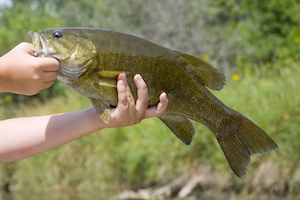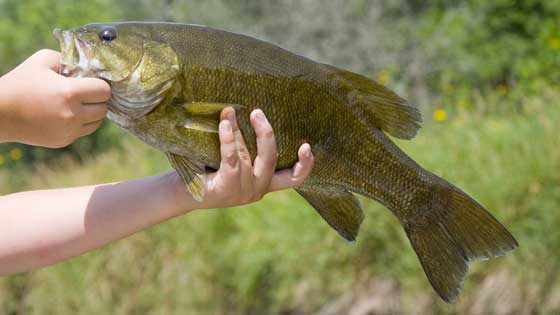Smallmouth Bass Summer Fishing

In the summer Smallmouth Bass change their depth often, ranging from shallow waters to waters as deep as 30 feet. They can move feeding locations many times during the day so sticking to one particular fishing hole isn’t a good idea. Be prepared to move from a location when it stops being productive.
A good spot that works one day can be completely dry the next.
*Don’t spend more than 30 minutes in a spot if it doesn’t yield any activity.
Food is their primary reason for changing depth
They can be lured into the depths by schools of small fish or found grazing the rocky shallows for crawfish. The other reason they’ll change depth is water temperature and bright sunlight.
Bright sun causes the Smallmouth to retreat for cover and warm water will push them into deeper, cooler water in the 60°F to 70°F range. 65°F is the optimal temperature.
Water temperature changes slowly from days to weeks while sunlight and food movements can cause Smallmouth Bass to change depth frequently throughout the day.
Fishing Technique
- When Smallmouth Bass are in deep water, always fish off the bottom by about 12 inches/30 centimeters.
- Plastic leech or worm presentations work very well at this depth.
Smallmouth Lures
Standard Smallmouth Bass lures include artificial or plastic worms and small split-tail plastic grubs.
- Weight the lures and retrieve them with little hops along the bottom.
- When the Smallmouth are following artificial lures but hesitant to strike, try crawfish, fathead minnows or even golden shiners.
While they can also be caught with dew worms, these will attract every fish in the lake and you’ll be pulling rock bass and perch off your hook instead of the larger game fish like Smallmouth Bass.
- The top bait is crayfish, (also known as crawfish) but avoid small ones as Smallmouth Bass are more attracted to larger baits.
Fishing with Crayfish
- A popular summer bait fish is a small live crawfish hooked near the end of its tail, or a shiner hooked through both lips
- Use a number 4 or number 6 hook attached directly to the line, with a light split shot weighted to bring the bait to the bottom
- Work the shiner slowly
- Retrieve the crawfish at a slightly faster, hopping pace, to prevent the crawfish from burrowing under rocks
Fishing Times – dawn and dusk
When there’s a lot of activity, Smallmouth Bass tend to stay under cover until nightfall.
- Try top-water fishing at dawn or dusk at any location where Smallmouth Bass are found during the day.
- Experiment with long, slender floater-divers and larger lures cast off rocky points in water 30 or more feet deep.
Smallmouth Bass produce spectacular twists and jumps the second the lure hits the surface or moments after the lure lies motionless.
Just before sunset and for a few hours after sunset, fishing for smallmouth bass is at its best, especially if there’s a lot of human and boat activity during the day.



